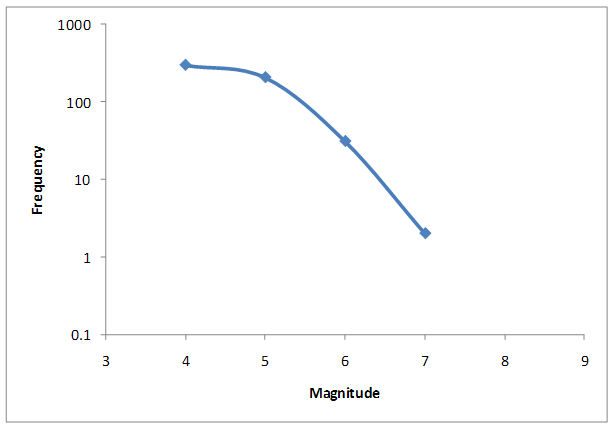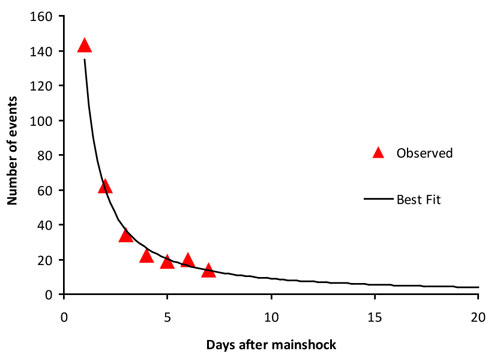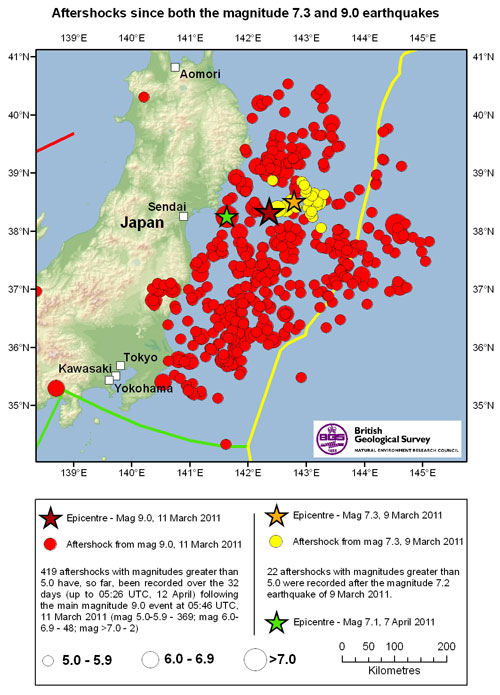Aftershocks Great Tohoku earthquake (north-east Honshu, Japan) 2011
Earthquakes of this size are always followed by extensive sequences of aftershocks which may last many months or even years, and may contain many thousands of earthquakes.
As of 06.30 on 18 March there had been 315 aftershocks greater than magnitude 5, 37 greater than magnitude 6 and one greater than magnitude 7.
Figure 1 shows the magnitude frequency distribution for the earthquakes recorded to date. Expected magnitudes may be as large as 7.9–8.0. So far, the largest aftershock has had a magnitude 7.1.
Aftershocks decrease in frequency as a function of time following the mainshock. This decay in the rate of aftershocks obeys a well know power law known as Omori's Law.
The decay for the Tohoku earthquake sequence is approximated in Figure 2.
Roughly speaking, we might expect that after ten days the rate of aftershocks to be around ten times less frequent than they were on the first day. The model can be used to estimate probabilities of future aftershocks.
On 18 March there was a probability of around 30 per cent of a magnitude 7 earthquake, or larger, in the following three days.
Further large earthquakes
Subduction thrust zones are usually highly segmented. Typically individual segments fail during a given earthquake.
However, there may also be an increased probability of further large earthquakes as a result of transfer of stress from the segment of the thrust zone that failed during the magnitude 9.0 earthquake to other adjacent segments.
This has been observed in recent years at the subduction zone west of Sumatra. Since the magnitude 9.3 earthquake of 26 December 2004, which produced the devastating Indian Ocean tsunami, a 2000 km segment that runs parallel to the Sunda trench has ruptured in a series of large earthquakes.
For example, the segment to the south of the 2004 earthquake failed during the magnitude 8.6 Nias Island earthquake of 28 March 2005.
Complex geometry of subduction zone
In this case the geometry of the subduction zone is rather more complex than Sumatra.
Northern Honshu lies on the Okhotsk Plate, a continental plate which some authors consider as part of the North American plate.
The oceanic Pacific plate is being subducted under the Okhotsk plate along the line of the Japan Trench. South of Tokyo, Honshu lies on the Amur plate, which some authors consider part of Eurasia.
To the east, the Philippines oceanic plate is being subducted under Southern Japan along the line of the Nankai trench. Further east, the Pacific plate is being subducted under the Philippines.
Contact
Contact Brian Baptie for further information.

- A Comparison of the Folkestone and Market Rasen Earthquakes
- Revised Seismic Hazard Maps for the UK
- Seismogenesis and State of Stress in the UK
- Monitoring Volcanic Eruptions Using Interferometry
- Particular events
- Are yesterday's earthquakes tomorrow's disasters?
- Creating 'virtual seismometers' deep inside the Earth
- Fault line living
- Is earthquake activity related to the Moon or Sun?
- Is earthquake activity increasing?
- Is earthquake activity related to the Moon or Sun?
- Is earthquake activity increasing? | April 2010
- Are yesterday's earthquakes tomorrow's disasters? | Sept 2010
- Creating 'Virtual Seismometers' deep inside the Earth
- Seismic interpretation of the Haiti earthquake
- Fault-Line Living expedition
- Afar Rift project - geological mapping





